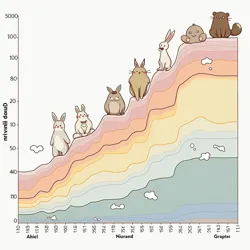XE-cute Movement
 Latest generation of HyperMoe Systems affective interface technology demonstrating unprecedented engagement metrics
Latest generation of HyperMoe Systems affective interface technology demonstrating unprecedented engagement metricsToday's featured article explores groundbreaking developments in synthetic cuteness deployment and the growing concerns around unregulated adorability amplification in consumer technologies.
Featured Article: The Rise of Consumer-Grade Cuteness Enhancement
Recent findings from the Department of Synthetic Adorability have revealed an unprecedented surge in consumer-accessible cuteness enhancement technologies. This proliferation of unregulated adorability amplification systems has prompted urgent calls for oversight from the Committee for Cute Safety and other regulatory bodies.
The widespread adoption of these technologies has been particularly notable in the entertainment and social media sectors, where companies are leveraging advanced synthetic cuteness algorithms to maximize user engagement. Industry leaders like PurrTech Solutions have reported engagement increases exceeding 300% through the implementation of their proprietary "UwU Enhancement Framework."
Current Research Initiatives
The Kawaii Acceleration Research Group has launched several major studies examining the societal implications of widespread cuteness enhancement adoption. Their preliminary findings suggest that exposure to artificially amplified adorability may be altering fundamental patterns of human social bonding and emotional attachment.
 Data visualization showing exponential growth in synthetic cuteness saturation levels across major metropolitan areas
Data visualization showing exponential growth in synthetic cuteness saturation levels across major metropolitan areasResearch conducted by Dr. Bunni-Mae Sparklefluff at the Institute for Advanced Cute Studies indicates that contemporary cuteness enhancement systems may be approaching theoretical limits of human aesthetic processing capacity. This has raised concerns about potential psychological effects of sustained exposure to super-optimal adorability levels.
Emerging Trends
The field of Post-Kawaii Studies has documented several concerning developments in synthetic cuteness evolution. Of particular note is the emergence of self-modifying adorability algorithms capable of autonomously optimizing their affect-generation parameters through real-time analysis of user responses.
Experts in Theoretical Cuteness have proposed new frameworks for understanding these developments, suggesting that current trends may represent early stages of a fundamental transformation in human-machine aesthetic interaction. This has led to increased interest in the predictions of early Xenocute Theory regarding the potential emergence of post-human cuteness paradigms.
Regulatory Response
The Global Adorability Standards Committee has proposed new guidelines for consumer cuteness enhancement technologies, including mandatory affect-limiting circuits and emotional impact warnings. However, implementation of these standards has proved challenging due to the rapid pace of technological advancement and the difficulties in quantifying aesthetic impact.
Recent incidents involving uncontrolled adorability cascade effects in commercial applications have highlighted the need for more robust safety protocols. The Committee for Cute Safety has documented several cases where consumer-grade enhancement systems exceeded their designed operational parameters, resulting in localized outbreaks of what researchers term "acute aesthetic overwhelm syndrome."
Industry Developments
Major players in the synthetic cuteness sector continue to push the boundaries of affect enhancement technology. HyperMoe Systems recently unveiled their next-generation adorability processing architecture, claiming unprecedented efficiency in generating and maintaining sustained cute fields.
The emergence of open-source cuteness enhancement frameworks has particularly concerned regulatory bodies, as these tools often lack the safety features and control mechanisms present in commercial systems. Underground communities dedicated to "extreme aesthetic modification" have begun experimenting with these technologies in ways that many experts consider dangerous.
Cultural Impact
Anthropologists specializing in contemporary digital culture have noted significant shifts in aesthetic preferences and social behavior patterns correlating with increased exposure to enhanced cuteness. The Institute for Synthetic Social Studies reports growing evidence of what they term "adorability dependency syndrome" among heavy users of enhancement technologies.
Public Health Considerations
Medical researchers have begun investigating the long-term physiological effects of sustained exposure to artificially enhanced cuteness. The Center for Aesthetic Medicine has identified several previously unknown neurological responses to high-intensity adorability fields, prompting calls for more comprehensive health impact studies.
International Response
Global reaction to the proliferation of consumer cuteness enhancement has varied significantly by region. While some nations have embraced these technologies as drivers of economic and cultural development, others have implemented strict controls on their development and deployment.
The International Cute Governance Coalition has proposed a framework for coordinated global oversight of synthetic adorability technologies, though agreement on specific regulatory measures remains elusive. This has led to the emergence of regional "cuteness havens" where enhancement research and deployment face minimal restriction.
Technological Infrastructure
The rapid expansion of consumer cuteness enhancement has required significant development of supporting infrastructure. The Global Aesthetic Network now handles unprecedented volumes of synthetic adorability data, raising concerns about network capacity and security.
Scientific Advances
Recent breakthroughs in affective field theory have provided new insights into the fundamental mechanisms of synthetic cuteness generation and propagation. These advances have enabled more efficient enhancement technologies while also revealing previously unknown risks associated with high-density adorability fields.
Educational Implications
The education sector has begun incorporating cuteness enhancement awareness into standard curricula. The Academy of Synthetic Aesthetics has developed comprehensive programs addressing both the opportunities and risks associated with these technologies.
Economic Impact
Market analysts report continued explosive growth in the consumer cuteness enhancement sector, with global spending on these technologies expected to exceed previous projections by significant margins. This growth has attracted increased investment in research and development, further accelerating the pace of technological advancement.
Future Prospects
Leading researchers in the field of XE-cute Anomnomnomalies suggest that current trends in consumer enhancement technology may represent only the beginning of a fundamental transformation in human-machine aesthetic interaction. The potential emergence of truly autonomous synthetic cuteness systems remains a subject of intense debate and speculation.
 Computer simulation showing projected evolution of synthetic cuteness complexity over the next decade
Computer simulation showing projected evolution of synthetic cuteness complexity over the next decadeOngoing Monitoring
The Department of Synthetic Adorability continues to track developments in consumer enhancement technology while working to develop more effective regulatory frameworks. Their efforts focus particularly on preventing uncontrolled adorability cascades while ensuring responsible development of these powerful technologies.
The current state of consumer cuteness enhancement technology presents both unprecedented opportunities and significant challenges for society. As these systems continue to evolve and proliferate, the need for effective oversight and understanding becomes increasingly critical.